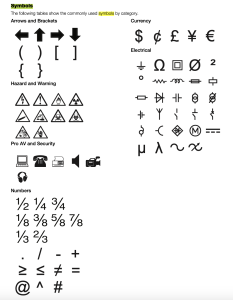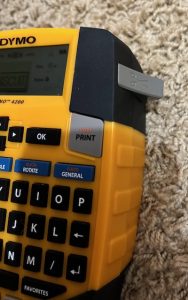Dymo Rhino 4200 Review

Dymo Rhino 4200
I am on a quest to find the perfect label maker. Recently, I got my hands on a Dymo Rhino 4200. I need to make this clear. My testing unit is a USED Rhino 4200.
I obtained it from eBay for an exceptional price. Mine included the case, rechargeable battery, power brick, and the machine had a Dymo original D1 cartridge installed (black lettering on white, 1/2″).
Even though this machine is used it seems to be in remarkable shape. I gave it a quick wipe down with isopropyl alcohol and it looks brand, spanking new.
However, on my first test after powering up the unit, the labels would not feed out correctly. The motor was pushing them but they were just bunching up in accordion fashion and not cleanly exiting the chute. A visual inspection didn’t really reveal any problems. It seems like maybe I now know why the unit was sold inexpensively.
I put another D1 cartridge in experienced no issues. Then I tried a heat shrink cartridge with no issues. Perfect printing was realized. After reinstalling the cartridge that came with the unit the problem returned. I pulled out about a foot of material and cut it off and tried again. At this point it began to behave. The problem seemed related to that cartridge. The material seemed to be curved or bending just enough to get stuck in the chute or just prior to the chute. Cutting the label or rather how you cut the label seemed to have an effect on that as well. More about that later.
It looks like I got a good label maker for a song.
First Impressions
Well, second impressions really after working through those initial issues. Again, I am on a quest for the perfect machine. This isn’t it, but it is a GOOD machine. Way more than adequate for most users.
One thing my label maker must do is to print on heat shrink tubing. I’m an electronics guy, and a networking guy. If I put a cable or wire in something I typically mark both ends of it during construction. Additionally, the larger the tape the machine can handle, the better. The Dymo Rhino 4200 handles a maximum of 3/4″ tapes. Not bad, but I own one label maker that does 1 1/2″ tapes.
Also i note that there is no connectivity to the label printer. That’s okay, but no connectivity means no updates, and no way to include custom or unique symbols on your labels. There is also no method to update the machines firmware. Before you buy one of these label makers I think it behooves the customer to review what symbols are included by reviewing the 4200 user guide. Below is an inclusive list of symbols.

Included Symbols
I personally own several lasers and there is no Hazard or Warning symbol for laser. I’m also an electronics guy and the mix of electrical symbols is pretty good. Again, a potential user should check for what is available before purchasing.
Functionality

Cutter
A couple of things of note here. Earlier I mentioned that the label would sometimes get stuck and get shaped like an accordion. I also noticed that how I pushed the cut lever had some effect on whether that happened or not.
If I lazily pushed in the cutter sometimes it wouldn’t even cut through and I’d have to take another bite at it. That probably introduced some kinking or misshape of the cut end that would cause it to get caught in the chute.
Conversely, if I did a crisp cutting action all seemed well and the label maker performed flawlessly.
I also noticed this…….and it was fairly substantial to me:
If I pushed print and then turned the machine to see the label coming out and then tried to cut from an awkward position………more often than not I would hit the print button again. I’m not prepared to call this a defect or “Dymo’s fault” but rather I need to adjust my way of using the label printer. Once you work through it a time or two it becomes second nature to not double print.
Conclusion: Push the cutter like you mean it, and hold the machine normally during printing and cutting operations.
Types of Tapes
There is a good variety of tapes and materials available for the Dymo Rhino 4200. Notably missing from the list are cable wraps and magnetic tapes. I like to use both of those things. Your mileage may vary.
3rd Party Labels
I generally don’t recommend the use of 3rd party labels but I don’t mind using them in label makers that I pick up on the used market at a great price. There are clone D1 cartridges aplenty for purchase. I just slapped some in the Rhino 4200 and they worked fine. The same cartridge however, does NOT work in my Dymo Rhino 6000+.
If inexpensive label refills really, really matter to you then you need an older Rhino 4200 instead of the Rhino 6000+.
Buttons
File this under “Read The Manual”. After unpacking the Rhino 4200 I tested the machine as anyone would. However, when I went to make text bold I couldn’t figure out how to do it. There is a button labelled STYLE/SIZE but it didn’t seem to get me where I wanted to go. After reading the manual I realized I had to push the ALT button + STYLE/SIZE to get to the menu I needed.
I guess what I’m saying is that it isn’t super intuitive to just pick up and use. The operator needs read through the manual.
And that is actually okay by me as well. These label makers perform some neat tricks which make repetitive labeling a snap. But they are also fairly complex actions. No matter who you are, you need to stick your face in the manual to perform some of these more advanced tasks.
Having said that, making text bold isn’t really an advanced task.
Overall Impressions
This is a good label maker. I also own the Rhino 5200 and Rhino 6000+. Both of those have a fairly huge hard case. Comparatively, the Rhino 4200 case is much smaller and lighter. It’s a bit easier to lug around.
Has my quest ended? Is it the perfect label maker? No. But it is a very good label maker. So far the label maker that is closest to perfect for me is the Epson LW-PX900. Some people say that Brady label makers are the closest to perfection.
But know this. If you review the symbol chart prior to purchase, and are willing to read a User Manual, this label maker could be your Huckleberry.
Before anyone buys any label maker they need to determine their needs. If you just want to label boxes in the garage, this may be overkill. Pick up a cheap label maker from Walmart (likely also a Dymo). If you want to do heat shrink tubing, this machine is a very economical choice that provides that capability. If your needs are met by this machine, it is a very good choice.
However, if you decide that in a year from now you’d like magnetic easy movable tapes on the steel shelves in the warehouse, you’ll need another machine such as that Epson I mentioned earlier.
Final Thoughts
I did this kind of backwards. I bought a Rhino 6000+ kit, then a Rhino 5200 kit, and now finally a Rhino 4200 kit.
The progression from the 4200 to the 5200 is notable. The 6000+ really ups the game with computer connectivity and the ability to print from software (which is Windows only).
I wish Dymo would add some magnetic tapes and cable wraps to their lineup though. My Dymo XTL 300 has flexible and laminated cable wrap cartridges available. I wish they would blend the two product lines together for that “perfect” label maker experience.
